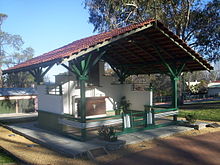Changi Chapel and Museum: Difference between revisions
Gryffindor (talk | contribs) |
(No difference)
|
Revision as of 21:30, 16 January 2008

The Changi Museum is a museum dedicated to Singapore's history during the Second World War.
In 1988, Singapore built a replica Chapel and Museum next to the Changi Prison. When Changi Prison was expanded in 2001, the Chapel and Museum was relocated to a new site 1 km away and the Changi Chapel and Museum was officially established on 15 February 2001. Bernard Stogden, the son of Sgt. Harry Stogden, was invited to place the cross that his father made onto the wreathed altar in the new Chapel.
The Museum has a collection of paintings, photographs and personal effects donated by former POWs. Among the collection is a series of paintings and sketches by a POW named William Haxworth which provide valuable insight on the daily life of the internees during the occupation. In 1986, Haxworth's wife donated a collection of over 400 paintings and sketches to the National Archives of Singapore.
Also in the museum is a collection of watercolour paintings by Mary Angela Bateman who was among the thousands of women and children held at Changi Prison for more than three years during the war.[1]
References
- ^ Nick Meo (2006-08-23). "Singapore war internee's art on show". BBC.
Literature
- Lenzi, Iola (2004). Museums of Southeast Asia. Singapore: Archipelago Press. pp. 200 pages. ISBN 981-4068-96-9.
External links
- Changi Chapel and Museum - Official Website
